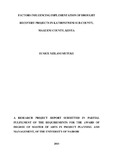| dc.description.abstract | Food insecurity persists in Kathonzweni Sub County as over 60% of the population in the
Sub County rely on relief food distribution every drought year. Despite significant food,
security projects initiatives in the Sub County, food insecurity and extreme rural poverty has
continued to pose major socio-economic problems to many households in the Sub County.
The transition rate of food poor households to self-reliance of food supplies has largely
remained inadequate. Many of the beneficiaries of the state sponsored food security project
interventions have frequently failed to put in place measures for self-reliance once the
sponsored project interventions get to an end and therefore food security has remained
elusive. This study was carried out purposed to assess the factors which influence
implementation of drought recovery projects in the Sub County. The specific objectives of
the study were ; to establish how food rations transfers to the targeted beneficiaries affect the
implementation of drought recovery projects; to examine how partners’ roles affect the
implementation of drought recovery projects; to establish how community participation
affects the implementation of drought recovery projects and to examine how gender affects
the implementation of drought recovery projects. The research was conducted in
Kathonzweni Sub County in Makueni County, Kenya. It mainly targeted all the food security
project initiatives implemented in the Sub County and the partners working together to
facilitate the implementation of these projects (WFP, NDAMA and WVK). The study
adopted a descriptive survey design and studied four divisions where drought recovery
projects are implemented within the Sub County. Respondents were 99, consisting of 95
beneficiaries of the projects, a representative of NDMA, WFP and WVK respectively. Data
was collected using questionnaires, interview schedules, observations and document analysis
checklists. The collected data was analyzed using descriptive statistics, content analysis, and
regression. The Statistical Package for Social Sciences (SPSS version 16) Computer
Application Package tool was used. The findings showed that institutional capacity factors
investigated, the projects’ operations strategies used to implement the projects and
technological inputs earmarked for these projects influenced their success but they are
applied to low extents in the Sub County. The findings revealed that the factors investigated
(food ration, partners roles , community participation and gender mainstreaming) accounted
for 42.1% variability in drought recover projects success in the Sub County while the
remaining percentage was due to other factors. The study concluded that the projects are not
delivering what they are supposed to, do not get results, and do not meet stakeholders’
expectations. They were found to be failing due to low extent application of desired
implementation factors, low extent applications of collaboration and partnership of all
stakeholders, and very low application of targeted technological inputs meant to drive these
projects to success. The study therefore recommended that, Community involvement at all
stages of project cycle, Advocacy on funding and dependency to sustain the project rather
than over reliance on donor, advocate on adoption to climatic change and finally National and
County government to support addressing food insecurity situation. | en_US |

